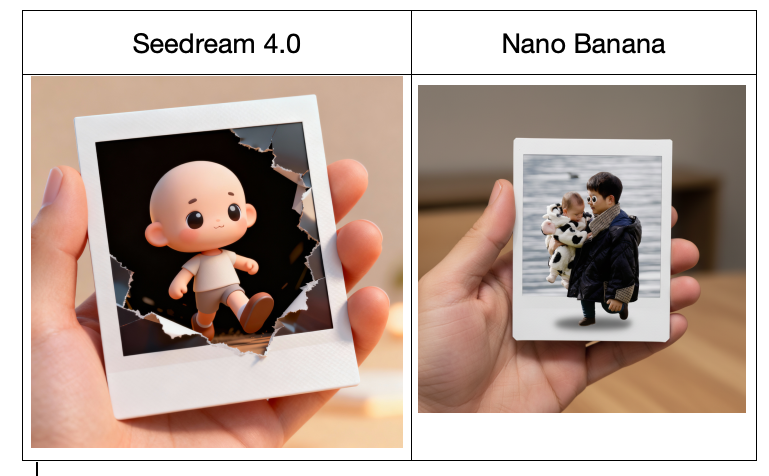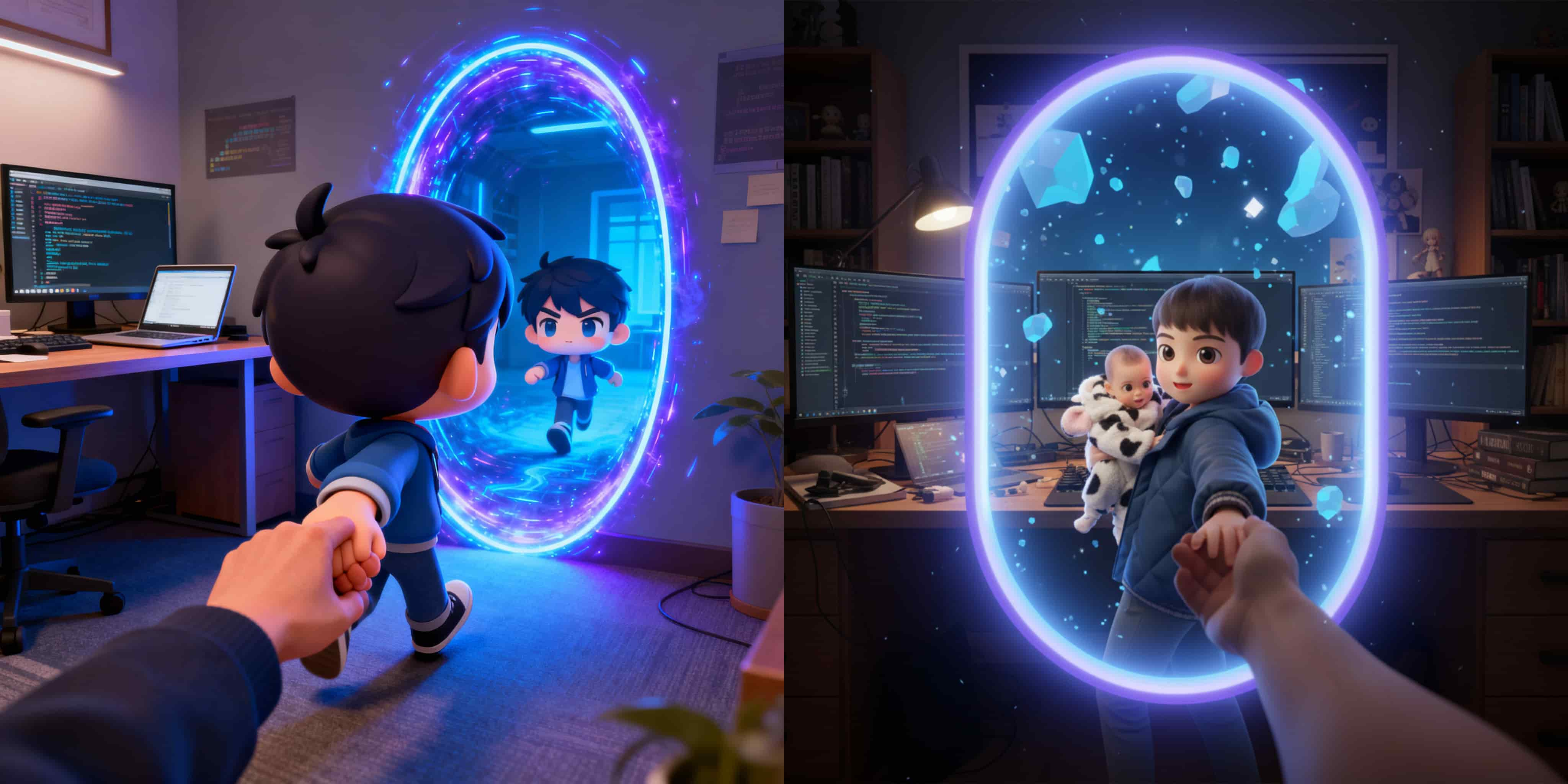Breaking Frames: Exploring the 3D Polaroid Breakout Effect
- Seedream 4.0
- Nano Banana
The Polaroid Breakout Effect represents a modern visual metaphor — a playful escape from the flat confines of photography into three-dimensional space. It requires an intricate balance of perspective, scale, and material fidelity to convincingly portray an animated subject crossing into the real world.
For this task, both seeDream 4.0 and Nano Banana must achieve a delicate harmony between real-world elements (hand, photo paper) and stylized digital characters, while maintaining believable lighting continuity and narrative cohesion.
Prompt:Convert the character in the scene into a 3D chibi-style figure, placed inside a Polaroid photo. The photo paper is being held by a human hand. The character is stepping out of the Polaroid frame, creating a visual effect of breaking through the two-dimensional photo border and entering the real-world 3D space.

Results & Observations
seeDream 4.0 Output
seeDream 4.0 demonstrates remarkable conceptual clarity and technical precision. The Polaroid frame appears convincingly tactile — slightly bent, matte in finish, and held naturally by human fingers with realistic skin tone and lighting falloff.
The chibi character bursts through the photo border with kinetic energy, its body half-emerging from the torn paper edges. The tearing effect, complete with subtle paper fibers and shadow depth, enhances the illusion of dimensional disruption. The character’s expression and proportions embody pure charm, maintaining emotional readability while existing convincingly within real-world light conditions.
seeDream’s standout strength lies in spatial cohesion — the seamless blending of physical and digital components through shared lighting and tone. The result evokes the visual impact of a high-end 3D commercial render or magazine cover concept.
Nano Banana Output
Nano Banana’s interpretation focuses more on warmth and storytelling than on visual trickery. The Polaroid is rendered with clean precision, held steadily by a human hand in a softly lit environment. Inside the frame, the chibi-style character interacts with a pet, creating a tender and personal emotional scene.
However, the breakout illusion is less pronounced — the character remains visually “inside” the photo, with minimal border disruption. While this approach sacrifices the striking dimensional leap of seeDream’s version, it gains narrative intimacy. The result feels like a moment preserved, a symbolic connection rather than a literal spatial breach.
Nano Banana thus prioritizes emotional coherence and clarity over technical illusionism, yielding a softer and more sentimental tone.
Conclusion
Both models successfully express the concept of dimensional interplay, yet they diverge in their artistic focus:
- seeDream 4.0 excels in technical realism and illusionary precision. Its image vividly conveys motion and transformation, capturing the thrill of a character escaping confinement — ideal for commercial or concept art contexts.
- Nano Banana, conversely, leans into narrative warmth and emotional connection. Its execution resembles a cinematic still — grounded, calm, and relatable, more fitting for lifestyle storytelling or personal illustration.
These differences highlight two complementary creative philosophies: seeDream’s photoreal innovation versus Nano Banana’s human-centered empathy.

Red Threads of Tradition: 3D Chibi Chinese Wedding Portraits
This article compares seeDream 4.0 and Nano Banana in their interpretations of a 3D chibi-style Chinese wedding scene, focusing on how each renderer balances realism, cultural symbolism, and emotional warmth. The task’s complexity lies in capturing the grandeur of traditional wedding attire while preserving the innocence and charm of chibi character design. The resulting works demonstrate two distinct visual philosophies—seeDream’s ornate realism versus Nano Banana’s symmetrical storytelling.
By Jackson 一 Oct 09, 2025- Nano Banana
- Seedream 4.0

Crossing Realities: The Portal of Dual Worlds
This analysis examines how seeDream 4.0 and Nano Banana interpret the Character Stepping Through Portal prompt — a complex, hybrid scene combining emotional storytelling, environmental contrast, and cinematic lighting. The challenge lies in merging two visual languages: the real-world environment of a programmer’s workspace and the fantastical 3D chibi world beyond the portal. Through this comparison, we explore how each model balances realism, fantasy, and viewer engagement.
By Jackson 一 Oct 09, 2025- Nano Banana
- Seedream 4.0

Dreamscapes in Miniature: 3D Cozy Room Design Analysis
This comparative review explores how seeDream 4.0 and Nano Banana interpret the Personalized Room Design prompt — a 3D isometric rendering of a cozy nighttime bedroom. The challenge demands mastery in warm lighting, spatial harmony, and emotional storytelling through stylized design. By evaluating how each system integrates architectural composition, atmosphere, and aesthetic tone, we gain insight into their respective strengths in environmental visualization and emotional design.
By Jackson 一 Oct 09, 2025- Nano Banana
- Seedream 4.0
- X
- Youtube
- Discord

